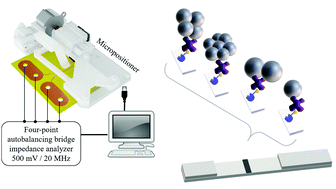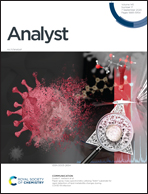Improved magnetic lateral flow assays with optimized nanotags for point-of-use inductive biosensing†
Abstract
Lateral flow assays may be used by minimally trained personnel for fast and inexpensive bioanalyses in decentralized non-exigent environments. Their extension to a broader catalog of applications depends on improvements in their quantification and their sensitivity. We report a strategy that combines nanomagnetic tagging of the analyte of interest with radiofrequency inductive sensing, easy to achieve in friendly and portable format. To optimize nanotag performance, we investigated the influences of their magnetic core size and agglomeration. Iron oxide nanoparticles, with sizes from 5 to 23 nm, were synthesized by thermal decomposition and then coated with dimercaptosuccinic acid and functionalized with neutravidin protein. We tested the system by immobilizing biotin in lateral flow membrane strips. When a sample containing the particles flows along the membrane, the biotin captures the neutravidin together with the magnetic nanotags, which are detected by the inductive sensor. The optimal nanotag core size is the critical threshold for superparamagnetic behavior, which maximizes both the initial magnetic permeability and the saturation magnetization. Controlled agglomeration of the nanotags increases the magnetic mass captured in the test line and further amplifies the signal.



 Please wait while we load your content...
Please wait while we load your content...